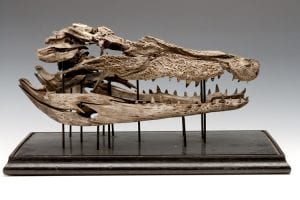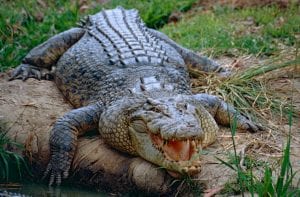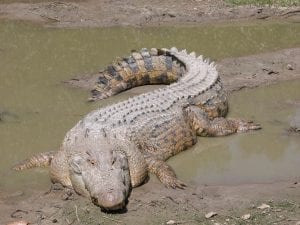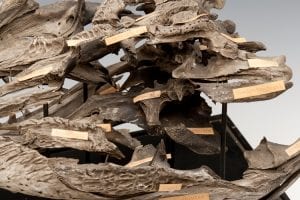Specimen of the Week 353: The exploded crocodile skull
By ucwehlc, on 27 July 2018
Specimen of the week this week is the skull of a giant predator which has been subject to a very special preparation method. The result is not only educational, but is surely the specimen of the week with the coolest name ever, allow me to introduce…
**The exploded crocodile skull**
This is a skull of Crocodylus porosus, the saltwater crocodile. This species is the largest living reptile, with some adult males growing longer than 6 metres. They live throughout eastern India, Southeast Asia, and northern Australia in freshwater, brackish and saltwater environments.
Saltwater crocodiles (or salties) have a wide range of prey including fish, mammals, reptiles, birds and crustacea, and some of the strongest jaws in the animal kingdom to eat them all with. You can read more about saltwater crocodiles and one of our non-exploded skulls here.
Full of beans
As you can see there is something a little different about this particular crocodile skull – it is a ‘Beauchêne’ or ‘exploded’ specimen. This preparation technique allows the structure of the skull and all the individual bones of the specimen to be seen.
The process was invented by Edmé Françoise Chauvot de Beauchêne (1780-1830), a Parisian doctor and anatomist. It is a laborious process, involving precisely no gunpowder, and is not as dramatic as it sounds. Exploded skulls are first cleaned thoroughly then soaked until the sutures (joints between the bones) loosen and the bones can be separated. Some preparators used to pack parts of the skull with dried beans before soaking, and as the beans absorbed water they would help to push the bones apart. The bones were then mounted on wires to show their place in the structure of the skull.
Make it snappy
The first exploded skulls were human ones used for anatomy teaching, but the practice spread to zoology and comparative anatomy collections because Beauchêne prepatations are so good for revealing the structure of the skull. This skull has each individual bone labelled, and some Beauchêne skulls even have mechanisms so you can slide the bones closer together or ‘explode’ them further apart.
As well as this crocodile the Grant Museum has dog, horse, sheep, turtle, ostrich and human exploded skulls on display, some of which have been in the museum since 1904.
Crocodiles ate are my homework
In his 1878 book The Skull of the Crocodile: A Manual for Students, L. C. Miall (who was Curator of Leeds Museum and Professor of Biology at what is now the University of Leeds) encouraged students to get out and find two crocodile skulls. Apparently they were easy to buy in large port towns. He instructed that one of the skulls should be disarticulated, although it seems Miall had not heard of the dried bean trick and preferred an more forceful approach –
“The process is troublesome, but not too difficult if much patience and little force are used. Begin at the end of the snout by separating and then removing the premaxillaries. A mallet and wooden wedges will be required.”
The Victorians had the best homework assignments.
The jaw bone’s connected to the…
One of the reasons the exploded crocodile skull is so useful is that is shows all the separate bones in the reptile jaw. Crocodiles have five bones on each side of their lower jaw (in case you were wondering they are the dentary, splenial, angular, surangular and articular). Most mammals have one bone on each side of their lower jaw, or in the case of adult humans a single bone that goes all the way round, this is the mandible. So what happened to all the others? In mammals most of the bones of the lower jaw fused to form the mandible, but the articular evolved to become the malleus, one of the bones of the inner ear
So there we have it, awesome hunting machine in life, useful teaching tool in death.
Stop Press!
Before you go we have some exciting news about Specimen of the Week! Starting next week we will be expanding the scope of SOTW to include the other UCL museums and collections. Keep your eyes peeled for blogs about specimens and objects from the Petrie Museum of Egyptian Archaeology, UCL Art Museum, UCL Pathology Museum and more as well as your favourites from the Grant Museum.
Hannah Cornish is the Curatorial and Collections Assistant at the Grant Museum of Zoology
References
- https://news.nationalgeographic.com/news/2012/03/120315-crocodiles-bite-force-erickson-science-plos-one-strongest/
- Spinner, R J, Vincent J-F, and Wolanskyj, Discovering the Elusive Beauchêne: The Originator of the Disarticulated Anatomic Technique, Clinical Anatomy 24:797–801 (2011)
- Miall, L C, 1878, The Skull of the Crocodile: A Manual for Students Macmillan https://archive.org/details/skullcrocodilea00mialgoog
- https://www.britannica.com/animal/reptile/Skull-and-dentition
 Close
Close





